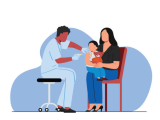Sep 16, 2010 (CIDRAP News) – Coverage levels for most of the older vaccines for small children stayed high last year even as rates for some recently recommended vaccines improved, the Centers for Disease Control and Prevention (CDC) reported today.
The CDC called the overall findings reassuring, but also cautioned that some localities may have sizable groups of children vulnerable to measles. A CDC official also voiced concern about pertussis (whooping cough) coverage in view of the current epidemic in California, in which nine infants have died.
"The survey shows that immunization of children 19 to 35 months old against vaccine-preventable diseases is high," Dr. Anne Schuchat, director of the National Center for Immunization and Respiratory Diseases, said at a morning news teleconference. "Fewer than 1% of children did not get any vaccines at all."
"Today's report is generally very reassuring despite concerns we've seen in the past about whether parents are continuing to have their children vaccinated," Schuchat said.
The findings come from the CDC's 2009 National Immunization Survey, a telephone survey backed by vaccination records from medical providers. The survey had a 64% response rate and included 17,313 children nationwide, according to today's article in Morbidity and Mortality Weekly Report (MMWR).
Among the recently recommended immunizations, coverage for the hepatitis B birth dose improved from 55.3% in 2009 to 60.8% in 2009, while hepatitis A coverage increased from 40.4% to 46.6%. Coverage for pneumococcal conjugate vaccine (PCV) was up less than 1 point at 80.4%.
The 2009 survey covered rotavirus vaccination for the first time and found a coverage level of 43.9%, the report says. The first rotavirus vaccine was approved in 2006 and a second one in 2008, Schuchat said.
"When you look at the youngest [children], born between January and June 2008, 60% had received the rotavirus vaccine series," she commented. "We're already seeing a very important drop in disease caused by rotavirus."
Uptake hovered around 90%, the national Healthy People 2010 goal, for several of the vaccines long recommended for children, the CDC reported.
Coverage levels for 2009 (and 2008) were: three or more doses of diphtheria, tetanus, and acellular pertussis (DTaP), 95.0% (96.2%); poliovirus, 92.8% (93.6%); measles, mumps and rubella (MMR), 90.0% (92.1%); hepatitis B, 92.4% (93.5%); and varicella (chickenpox), 89.6% (90.7%).
"These findings demonstrate the ability of immunization programs at the state and local levels to incorporate newly recommended vaccines while sustaining coverage at or above national target levels for most longer-standing recommended vaccines," the MMWR article states.
Schuchat said the drop in measles vaccine coverage was not large but added, "On the other hand, nationally measles coverage rates can be high—90% is the target—and you can still have communities with large pockets of susceptible children."
In a press release, the CDC said the nation had some measles outbreaks in 2008 in children whose parents had refused to have them vaccinated. "With measles we can never let down our guard," said Schuchat.
Regarding pertussis vaccination and the California epidemic, Schuchat commented, "We think the principal challenge there is ongoing pertussis transmission in teens and adults," not vaccine coverage in babies and toddlers.
Calling the California epidemic "serious," she said the CDC is working with California health officials to promote booster vaccination of teens and adults. "Other people who are around young babies really do need to get the DTaP vaccine," she said. "It was licensed in 2005, and many adults didn't know you were supposed to get it."
The CDC said 83.6% of toddlers received three doses of Haemophilus influenzae type b (Hib) vaccine, down from 90.9% in 2008, reflecting a national shortage of the vaccine in 2008 and 2009. The shortage is over now.
The survey found wide variation by state in coverage for the newer vaccines. It also revealed some disparities among racial and ethnic groups and linked to poverty status.
For example, PCV and rotavirus coverage was lower for black and multiracial children than for white children, and Asian children had lower PCV coverage than whites. The report says the Vaccines for Children program has reduced some potential gaps in coverage related to poverty, but some remain.
CDC. National, state, and local area vaccination coverage among children 19-35 months—United States, 2009. MMWR 2010 Sep 17;59:36(1171-77) [Full text]
See also:
Sep 16 CDC press release
http://www.cdc.gov/media/pressrel/2010/r100916.htm



















